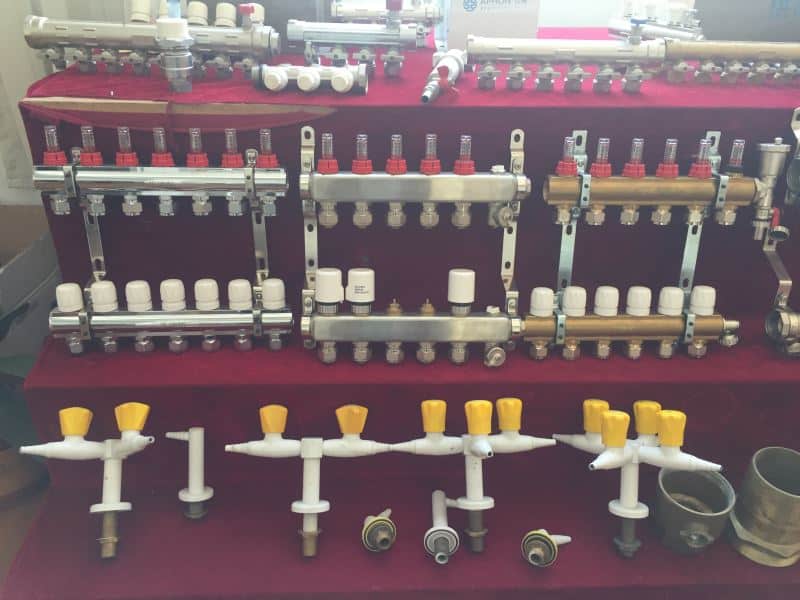Learn From This Article.
Discover the world of PEX heating manifolds and learn about their types, specifications, pressure, size, raw materials, installation, maintenance, and supplier selection to make an informed decision for your radiant heating system.
Introduction:
PEX (cross-linked polyethylene) heating systems have seen a surge in popularity due to their durability, efficiency, and cost-effectiveness. Central to the efficiency of such systems is the heating manifold, which acts as a central hub, distributing heated water to various zones or rooms. In this guide, we’ll dive deep into the types of PEX heating manifolds, their specifications, and more.

1. Types of PEX Heating Manifolds
1.1. Stainless Steel Manifolds
- Overview: Stainless steel manifolds are known for their high strength and resistance to corrosion, making them ideal for long-term usage.
- Advantages: They offer high thermal resistance, are less prone to leakage, and are ideal for high-temperature operations.
1.2. Brass Manifolds
- Overview: While not as strong as stainless steel, brass manifolds balance cost and durability.
- Advantages: Brass has natural corrosion-resistant properties, and these manifolds are often more accessible to machine and install.
1.3. Polymer Manifolds
- Overview: Made from high-grade plastics, polymer manifolds are lightweight and resistant to rust.
- Advantages: They don’t suffer from mineral build-up, are lightweight, and are often more affordable than their metal counterparts.
2. Data and Specifications
2.1. Number of Loops/Outlets: Depending on the size of the area or the number of zones you’re heating, PEX manifolds can have anywhere from 2 to 16 outlets(loops and ways).
2.2. Manifold Spacing and Length The length of a manifold and spacing between outlets vary. Manifolds might span several feet for larger systems, with outlets spaced evenly for optimal water distribution.
2.3. Flow Meter and Balancing Valves High-quality PEX manifolds come with flow meters to monitor water flow and balancing valves to ensure even heat distribution across all outlets.
2.4. Temperature and Pressure Gauges For safety and efficiency, many manifolds include gauges that monitor the temperature and pressure of the circulating water.
3. Pressure and Size
3.1. Operating Pressure Range Most PEX manifolds operate within a range of 20-200 psi, suitable for both residential and commercial applications.
3.2. Inlet and Outlet Connections Common inlet sizes range from 3/4″ to 1″, while outlets typically fit 1/2″ PEX tubing.
3.3. Compatible PEX Tubing Sizes Manifolds are generally compatible with standard PEX tubing sizes, most commonly 3/8″, 1/2″, and 5/8″.
4. Raw Materials
4.1. Stainless Steel This alloy, made primarily of iron, carbon, and chromium, offers unparalleled strength and corrosion resistance, making it a premium choice for manifolds.
4.2. Brass: A combination of copper and zinc, brass provides excellent malleability and resistance to corrosion. Its natural properties help prevent mineral deposits.
4.3. Polymer Polymers used in manifolds are typically high-grade, heat-resistant plastics. These offer the benefits of being lightweight and immune to rust.
When setting up a PEX heating system, the manifold you choose plays a crucial role in the efficiency and longevity of the system. By understanding the types, specifications, and raw materials of PEX manifolds, you can make an informed decision that ensures a warm and cozy environment for years to come.

PEX Heating Manifold Accessories
7.1. Actuators: Electric or thermal actuators can be added to the manifold’s zone valves for individual loop control and integration with a thermostat or home automation system.
7.2. Air Vents: Automatic air vents help eliminate trapped air in the manifold and maintain optimal system performance.
7.3. Mounting Brackets: Brackets for wall-mounting your manifold ensure proper support and positioning.
7.4. End Caps: End caps provide a clean and finished appearance to your manifold while preventing dust and debris from entering the system.
Energy Efficiency and Environmental Considerations
8.1. Insulation: Adding insulation to your PEX heating manifold can help reduce heat loss and improve overall system efficiency.
8.2. Zoning and Control: Implementing zoning with individual loop control can optimize energy consumption by only heating areas in use.
8.3. Leak Detection: Regularly inspecting your PEX heating manifold and tubing for leaks can prevent wasted energy and potential damage to your property.
Retrofitting and Expansion Options
9.1. Modular Design: Some PEX heating manifolds feature a modular design that allows for easy expansion or modification to accommodate changes in your heating system.
9.2. Compatibility: Ensure the selected manifold is compatible with your existing or planned PEX tubing size and other system components.
9.3. Adapters and Fittings: Utilize adapters and fittings to connect your new PEX manifold to existing or different types of tubing, if necessary.
Troubleshooting Common Issues
10.1. Uneven Heating: If you experience uneven heating across different loops or zones, ensure the flow meters and balancing valves are correctly adjusted, and the manifold is appropriately sized for your system.
10.2. Noisy Operation: Noise from the manifold could be due to trapped air, debris, or improper balancing. Inspect and clean the manifold and adjust the balancing valves as needed.
10.3. Leaks: Regularly inspect the manifold and connections for leaks, and replace any damaged components or tighten connections as necessary.
Understanding the various aspects of PEX heating manifolds, including types, specifications, pressure, size, raw materials, installation, maintenance, accessories, energy efficiency, retrofitting options, and troubleshooting common issues, is crucial for making informed decisions when selecting the right product for your radiant heating system.
Selecting a Reliable Supplier
PEX heating manifolds are essential to radiant heating systems, providing efficient heat distribution and control. Understanding the various aspects of PEX heating manifolds, such as types, specifications, pressure, size, raw materials, installation, and maintenance, is crucial for making informed decisions when selecting the right product for your system. Additionally, choosing a reliable manifold factory is vital for ensuring the success of your radiant heating project. Considering these essential factors, you can confidently choose the right PEX heating manifold.

